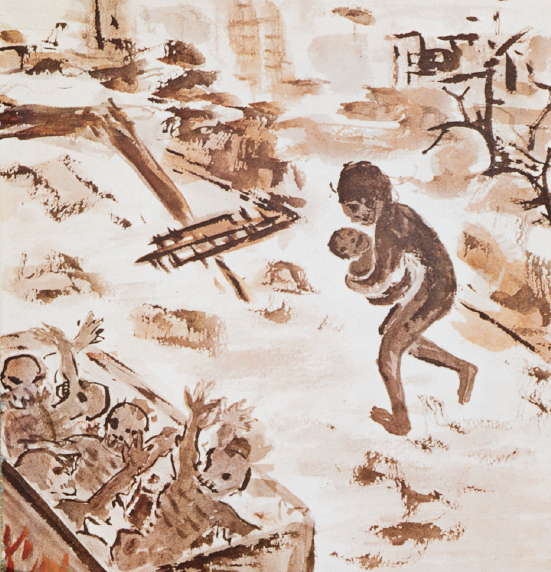The War in the Pacific, 1942–1945
In April 1942 the Japanese devised a plan to take Port Moresby in New Guinea and also destroy U.S. aircraft carriers in an attack on Midway Island (see Map 30.3). Having broken the secret Japanese code, the Americans skillfully won a series of decisive naval victories. First, in the Battle of the Coral Sea in May 1942, an American carrier force halted the Japanese advance on Port Moresby. Then, in the Battle of Midway in June 1942, American pilots sank all four of the attacking Japanese aircraft carriers and established overall naval equality with Japan in the Pacific.
The United States gradually won control of the sea and air as it geared up its war industry. In July 1943 the Americans and their Australian allies opened an “island-
The Pacific war was brutal and atrocities were committed on both sides. Aware of Japanese atrocities in China and the Philippines, the U.S. forces seldom took Japanese prisoners after the Battle of Guadalcanal in August 1942, killing even those rare Japanese soldiers who offered to surrender. American forces moving across the central and western Pacific in 1943 and 1944 faced unyielding resistance, and this resistance hardened soldiers as American casualties kept rising. A product of spiraling violence, mutual hatred, and dehumanizing racial stereotypes, the war’s brutality intensified as it moved toward Japan.

In June 1944 U.S. bombers began a relentless bombing campaign of the Japanese home islands. In October 1944 American forces under General Douglas MacArthur landed on Leyte Island in the Philippines. In the ensuing Battle of Leyte Gulf, the Japanese lost 13 large warships, including 4 aircraft carriers, while the Americans lost only 3 small ships. The Japanese navy was practically finished.
In spite of massive defeats, Japanese troops continued to fight on. Indeed, the bloodiest battles of the Pacific war took place on Iwo Jima in February 1945 and on Okinawa in June 1945. American commanders believed that an invasion of Japan might cost 1 million American casualties and possibly 10 to 20 million Japanese lives. In fact, Japan was almost helpless, its industry and cities largely destroyed by intense American bombing. As the war in Europe ended in April 1945, Japanese leaders were divided. Hardliners argued that surrender was unthinkable. A peace faction argued that Japan should seek a negotiated end to the war.
On July 26 Truman, Churchill, and Stalin issued the Potsdam Declaration, which demanded unconditional surrender. The declaration left unclear whether the Japanese emperor would be treated as a war criminal. The Japanese, who considered Emperor Hirohito a god, sought clarification and amnesty for him. The Allies remained adamant that the surrender be unconditional. The Japanese felt compelled to fight on.
On August 6 and 9, 1945, the United States dropped atomic bombs on Hiroshima and Nagasaki in Japan. Also on August 9, Soviet troops launched an invasion of the Japanese puppet state of Manchukuo (Manchuria, China). To avoid a Soviet invasion and further atomic bombing, the Japanese announced their surrender on August 14, 1945. The Second World War, which had claimed the lives of more than 50 million soldiers and civilians, was over.
>QUICK REVIEW
How did the Nazi’s racial ideology shape German wartime policies and priorities?